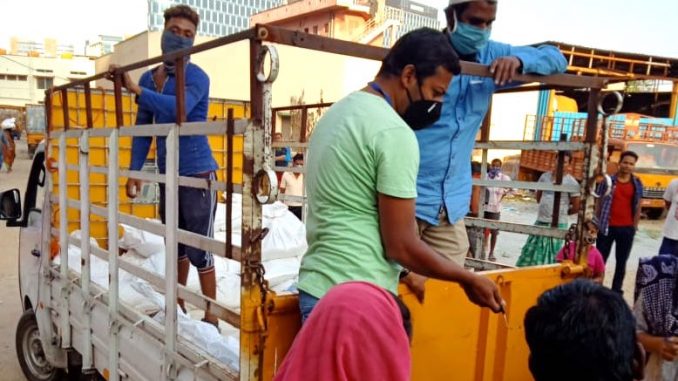Hunger has stalked Maiduna Begam and her four children for the past 16 months. Except for a brief period after the first unlock last year, Maiduna’s husband, a mason’s helper, has been jobless for most of this period and lost his mother as they could not afford proper medical treatement.
“We manage two meals a day with difficulty,” says Maiduna, who hails from Raichur. “We have not paid rent for three months, and our landlord is threatening to evict us”. Two weeks ago, she found work as helper at a tailoring shop, but the job pays only around Rs 4,000 per month, much less than what her husband used to earn pre-COVID.
For Bangalore’s migrant workers, whether from within or outside the state, this struggle for survival continues. It was bad during last year’s first lockdown. It became worse during and after the second lockdown this May. A third lockdown, if it happens, will probably ring their death knell. As many who lost their jobs are yet to find work. And volunteer groups helping migrant workers have scaled down their operations even as many like Mainuda are still in need of rations.

Some found work through networks
Many jobless have found new jobs through their social social networks, though these may last only till the next lockdown. Like Wahidulla from Assam, a construction worker in Bengaluru for over two years, jobless and without support during both lockdowns. This time, as the lockdown ended, Wahidulla did get a call from his contractor to return to work. But traumatised by his past experience, he has decided to not go back to construction work again. Instead, through his networks, he found work as a security guard. “The pay is almost the same as earlier,” he says. “I picked this job because I heard security guards have work even during lockdowns”.
Read more: Urban employment guarantee: “Desperate times call for desperate measures”
But the sad truth is there’s no job security for workers like Wahidulla, especially during lockdowns.
Somnandan from Odisha had worked as a security guard since his arrival in Bengaluru last November. The security agency fired him immediately after the lockdown was announced. He managed one month of lockdown on his last salary. Then he started borrowing to buy essentials, accumulating a debt of Rs 5,000 so far. After three months of unemployment, he was able to get housekeeping work in a store in July and later became a security guard.
Those who left last year have it worse
Those who went back home last year, however, have had it worse since their return to Bengaluru. Most remain jobless as their previous employers have hired others. Having come back a couple of months before the recent lockdown, their condition is just as bad as during last year’s lockdown.
Before the first lockdown in 2020, Arif Ansari from Jharkhand worked as a security guard in Hennur earning Rs 10,000 per month, half of which he sent home to his wife and two children. He left for his village last year as the company didn’t pay him during lockdown. “I did farm work in Jharkhand, but it wasn’t enough, so I had to return to Bengaluru,” says Ansari. “But soon after, the second lockdown started”.
Stranded without money or food once again, he is now relying on friends to accommodate him temporarily and on volunteer groups that give rations. His search for a job has been in vain so far.
Are conditions any better for those who stayed put in their villages? Like Nirmal Mandi, also from Jharkhand. Nirmal and his brother had been tailors at a garment factory in Bommanahalli, each earning Rs 10,000 per month. “Once the 2020 lockdown in Bengaluru lifted, the factory manager asked us to return to work,” says Nirmal. “But Jharkhand had a much longer lockdown and there were no trains to return to Bengaluru then. Also our parents were worried we’d get stranded in further lockdowns. So we couldn’t return”.

Nirmal has been doing farm work, but there’s work only 15 days a month that pays just Rs 250 per day. He wants to return to Bengaluru, but his previous employers aren’t picking his calls now. “I’ll return only after finding work,” says Nirmal. “Else it will be like last time, struggling without food and rent payment. Half the workers who had returned with me to Jharkhand remain here”.
Their fears are real, of another lockdown, of no job security, and inaccessibility to any kind of government relief.
Roshan Kumar, who used to be a construction worker, was affected by both lockdowns and doesn’t want to work in any city again. He had left Bengaluru for his home in Bihar last year. He later worked for a month in West Bengal, but with lockdown there, came back to Bengaluru this January. There was construction work for a couple of months, which stopped again with the latest lockdown.
“The contractor arranged rations for me, he hasn’t yet paid my dues of Rs 6,000-7,000,” says Roshan. He got Rs 1,000 on calling a helpline, and with that, returned to Bihar. He doesn’t have any work currently, but doesn’t want to risk migrating to cities again because there could be more lockdowns. He plans to manage with whatever farm work he gets in his village.
Gayathri Vasudevan, who heads the organisation LabourNet which helps former migrant workers return to Bengaluru and get placed in manufacturing sector jobs, says the travel itself is an ordeal for many workers.
“Even before the second lockdown, there were few trains from eastern states like Bihar and West Bengal, to Bengaluru,” says Gayathri. “And those who returned have to find work with new contractors, and the area they stay in are often far from their workplace which increases transport costs”.
Read more: Low ridership, high fares: COVID nudging BMTC into vicious circle
Why didn’t we hear much about migrant workers in second lockdown?
Unlike last year’s lockdown, we heard little about migrant workers in Bengaluru this time around. Even volunteers working on the ground said they didn’t get too many calls for help. Though the lockdown started in April end, calls from migrants started coming only in mid-May, says Seema Mundoli, member of the volunteer group Stranded Workers Action Network (SWAN). “This was probably because the workers had already been paid for April, and they hoped the lockdown would be only for two weeks as initially announced”.
Munawar, a volunteer who supplied ration kits to migrant families in Attibele and Bommasandra, says many workers who had returned to their home states “were very poor workers who had suffered during the last lockdown and wouldn’t have been able to survive the second lockdown. The rest were drivers, loading workers, factory employees, domestic workers, etc., who managed to get work for fewer days.” He says the pay for these workers ranged from 20-50% of their usual wages during lockdown.
Given the possibility of another lockdown, there is little hope that migrant workers will be able to get and sustain sufficient work with reasonable pay. As workplaces are cutting back hugely on numbers and productivity with each lockdown. And access to state support remains uncertain for them.